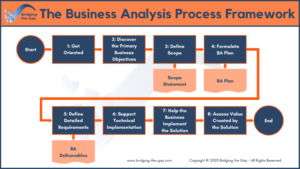The most nerve-wracking question for a business analyst is, perhaps, wondering what the secret to an efficient business analysis of a company is. With a new project at hand, what boggles a relatively inexperienced business analyst’s mind are questions like what exactly is expected of them, what deliverables they should be creating, and how to ensure success on the project. So, if you’re one of them, you’ve come to the right place!
This article will focus on the significance of conducting business analysis and elucidate the various steps you can apply to your business analysis project.
Importance of Business Analysis
In simple terms, business analysis entails recognizing business needs and discovering solutions to various business problems. It is all about understanding the functioning of an organization that leads to its business purpose. It also involves recognizing the firm’s abilities to deliver its products and services to external stakeholders.
Business analysis of a company has impactful repercussions on the company’s finances and more. Here’s how:
- Business analysis is a cost-effective method to address recurring business problems and come up with affordable solutions.
- A significant aspect of business analysis is understanding the business in detail, its requirements, what drives its growth, and what may hinder its progress.
- It offers clarity on various decision-making processes involving the overall company expenditure, margin of profits, etc., and conveying them to investors and stakeholders.
- It is a crucial method to assess business valuation in terms of ROI.
- Business analysts are your best bet if you want to know your company’s market standing.
- Business analysis prepares you for crises.
- Only a business analysis can say if changes to business processes have brought about any kind of impact at all.
Also Read: 5 Exceptional Services Growing Businesses Need
Steps Involved in Conducting the Business Analysis of a Company
A business analysis phase is crucial before the commencement of any project. Whether it’s a one-week project you are working on or a billion-dollar one, business analysis is something you can’t ignore!
There are usually many steps involved in the process of business analysis of a company. Each stage consists of the performance of specific tasks according to defined principles with subsequent production of documents. Depending on the project type, these steps and principles may differ in frequency of occurrence or order. They may also be longer or shorter, depending on the project you are handling.
Source
So, let us go through a detailed description of each of the eight steps in the business analysis of a company:
Step 1: Orientate
It is impractical for a business analyst to dive head straight into a project without any homework on the project background. Hence, the first step is to get oriented by clarifying the business’s scope, demands, and objectives. It also includes elucidating the business analyst’s role, determining the primary stakeholders, understanding the project history, and the existing processes and systems.
Step 2: Establish the primary business objectives
It is a crucial step before the business analyst goes on to define the project’s scope. In this step, the business analyst uncovers the primary stakeholders’ expectations, reconciles clashing expectations, ensures that the business objectives are achievable, and sets the stage for defining the project scope in the subsequent step.
Step 3: Define the scope
The business analysis scope is essential since it gives a vision to the project team to go ahead and realize the business needs. The scope includes guidance steps to direct the business analysis process towards fruition. Here, the business analyst defines the approach needed to bring about technological and process changes to achieve solutions to the primary business objectives, draft a scope statement, review it with stakeholders, and confirm the business case.
Step 4: Develop a business analysis plan
The plan provides coherence to the business analyst and helps in defining the business requirements later on. In this step, the analyst’s primary tasks involve choosing suitable business analysis deliverables according to the project’s critical attributes, specifying the list of deliverables (covering the scope and identifying the deliverables), and setting the timeline for completing the said deliverables.
Step 5: Define the detailed business requirements
Defining the detailed business requirements makes the business scope actionable and gives the implementation team the information to devise the solutions. Here, the business analyst gathers information to understand the business’s needs, analyses the data to prepare a draft, stating the business analysis deliverables, reviews and validates the deliverables with stakeholders, and fills any remaining gaps.
Step 6: Support the technical execution
It is a step involving the technical implementation team, building, customizing, and deploying software. Here, some of the business analyst duties include scrutinizing the solution design, updating the requirements documentation, coordinating with the QA professionals, resolving any issues that crop up, supervising requirements changes, and heading user acceptance testing attempts.
Step 7: Assist the business to apply the solution
The business analysts must ensure that the business does justice to the solutions by utilizing them aptly. Hence, the analyst analyzes and develops the business process documentation stating what changes have to be made to the business process. Business analysts should also train end-users and collaborate with business users to ensure that the overall business community is ready to embrace the changes.
Step 8: Evaluate the value added by the project
The business analysis process’s last leg involves assessing the progress across the business objectives and timeline, providing updates to stakeholders, and suggesting modifications based on the feedback and progress. It is an opportunity for changes and enhancements.
Conclusion
The ultimate aim of every business is to attain strong leverage in the financial market. In today’s rapidly changing market scenario, only companies that identify problems and stick to solutions can expect to succeed. The last few years have witnessed business analysis taking a paradigm shift towards innovative approaches to guarantee the best outcomes in terms of business solutions. In this light, it becomes necessary to talk about the steps involved in the business analysis of a company. The business analysis steps discussed in this article are fundamental to any analysis irrespective of the business size. In order to learn business analysis in depth and implement the same to improve your business, you can enroll in a business analysis certification training program.






